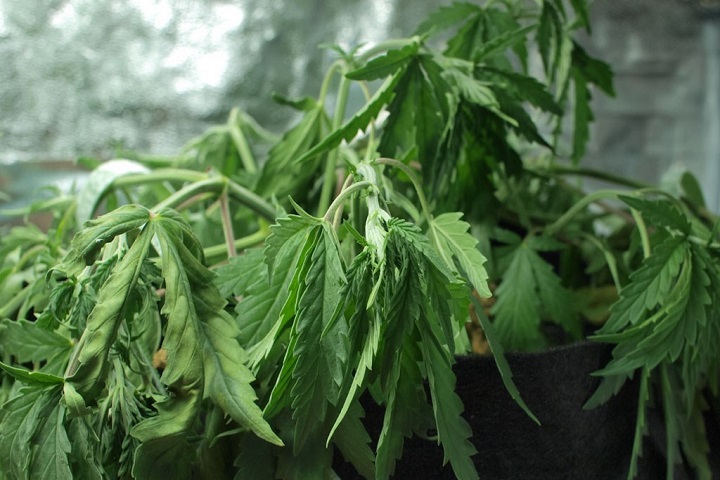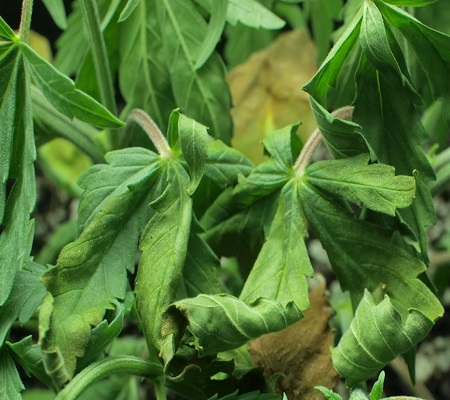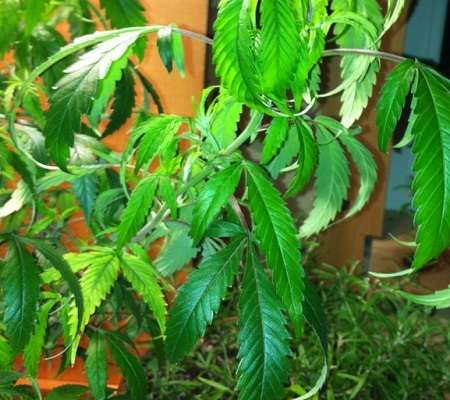
Improper watering can come from a lot of reasons. Some include the size of the plant and volume of the container, the root system, the grow room or outside temperature, how humid the air is, and how mature your plant is. If your plant is large, it will need more water, and vice-versa. If your plant is in a container that is quite large, you won’t need to water as often or cover as much space with the water. If the temperature is high, more water is required; if the humidity is also high, however, less water is required. Plants in the midst of their flowering period won’t need as much water.
All of these factors come into play when you are trying to establish how much water your marijuana plants need. But, the most important thing to pay attention to is any signs that your plant might be exhibiting, showing that it is receiving too much or too little water. If it doesn’t have the right amount of water, your plant’s health could be at risk.
Underwatering

The two risks to pay attention to are overwatering and underwatering. Underwatering is the easiest to identify and fix, but if it goes on too long, then your plant will slow down its growth and eventually die. If your plant is wilting (as opposed to drooping), it doesn’t have enough water. This can be fixed simply by watering your plants more -- whether it’s more often, more frequently, or both.
Download my free marijuana grow guide and learn to grow like a pro!
The main thing to remember when adding more water to thirsty plants is to do so without any fertilizer. Fertilizers can worsen the problem. You should make sure the water has a balanced pH level and doesn’t have anything added to it.
Overwatering

Overwatering is, unfortunately, a relatively common problem, especially among new marijuana growers. The key is to recognize it early on and then take action right away. You will know your plants are being overwatered if their leaves are drooping (not wilting) and your plant just generally appears exhausted and lacking its former health and vibrancy. Note: drooping leaves are completely curled while wilting leaves just have the tips curling.
With overwatering or underwatering, growth will slow down. In the case of overwatering, this is because there isn’t enough oxygen for the plant to function properly.
An easy way to avoid overwatering is by first checking the soil to ensure it is dry by putting a finger an inch within the top layer of soil. If the soil is totally dry, it is safe to water your plants. If you check this multiple times and it is not getting any drier, then there is likely a problem with the drainage in the container, or else you are watering too much or too often.
One technique to see if a container-grown plant is ready for more water is just to lift up the container. If it feels light enough, it is probably dry and ready for a watering. If it’s heavy, there is likely still plenty of water left in the pot. This is a tricky technique for some people at first, especially if they are unfamiliar with how heavy or light the pot normally is. An easy way to get used to it is to have a pot next to it that is filled with the same type of soil (or other growing medium). Keep that pot unwatered and unplanted, making it an easy comparison to see what the weight of a “light,” dry pot is. Simply lift each one and see if they are the same weight. After a while, you should no longer need this extra pot to feel the weight; you will have trained yourself to feel for yourself whether the pot is dry or not.
Download my free marijuana grow guide and learn to grow like a pro!
Once you recognize the fact that your plants are being overwatered, you will need to take immediate action. For container-grown marijuana plants, check the drainage holes and clear them out if necessary. Or, if you realize that there aren’t drainage holes at all, quickly cut some into the bottom of your pot -- without them your plants simply won’t be able to survive.
If drainage holes aren’t the source of the issue, your soil might be made up of particles that are too small and don’t allow water to move through them easily and freely enough. Test this by seeing how long it takes for any water to drain out the bottom after watering the soil -- if it takes longer than a minute, then you need to compensate by watering less frequently. Next time, choose soil that is more aerated or is coarser.
An outdoors growing area comes with its own sets of difficulties, depending on your location and what the natural soil is like. If the soil is more clay-based, it won’t drain the water very efficiently. This means any amount of rainfall could have a stronger and longer lasting effect. Compensate by changing the frequency or amount of watering that you do. You can also lower the moisture level within soil by poking holes in the top layer with a writing utensil.
If you have overwatering problems and you are growing your marijuana plants in a hydroponic system, the problem is actually in the roots rather than the water. It is highly possible that a lack of oxygen is to blame, so either install an air pump or add in air stones to remedy the issue.
If you aren’t growing your plants in a hydroponics system, the problems you’re seeing could still be related to root issues rather than directly from watering problems. Root rot, for example, leads to wilting or drooping of the leaves of your marijuana plants, which can cause new (or even more experienced) growers to misdiagnose what is really the cause.
Thanks for reading. Please leave comments or questions below and don’t forget to download my free grow bible and/or visit us at Ilovegrowingmarijuana.com